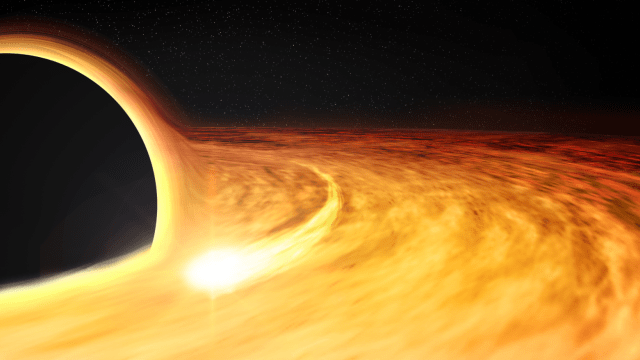Scientists have measured a fundamental property of a supermassive black hole — how fast it spins — by measuring a star slamming into it.
It can be hard to measure black holes unless they actually do something, like when they slam together or spew jets of matter. But the scientists behind the new result were able to measure the mass and spin of a quite massive black hole, demonstrating that these brief star-eating events, called tidal disruption events, could offer another way to understand black holes.
“There have already been measurements of spins from black holes that are actively accreting,” or acquiring more matter under the influence of gravity, the study’s first author Dheeraj Pasham, Einstein Postdoctoral Fellow at the MIT Kavli Institute, told Gizmodo. “This measurement is different in the sense that we were able to measure the spin of a black hole that was dormant,” at least until the tidal disruption event occurred.
An automatic sky survey called the All-Sky Automated Survey for SuperNovae, or ASASSN, spotted the flash on November 22, 2014. The flash, called ASASSN-14li, looked just like your typical black-hole-gravity-shredding-a-star-to-bits event, happening near the center of a host galaxy. The scientists immediately searched for “quasi-periodic oscillations,” regularly repeating but changing patterns of x-rays that vary in their power and are thought to originate from very close to the black hole. They found what they were looking for in data from two x-ray space telescopes.
Scientists used these x-ray emissions to infer the black hole’s mass and spin. And in this case, the researchers estimated that the mass was between a few hundred thousand and 10 million times the mass of the Sun, and the spin was an incredible 50 per cent the speed of light, according to an MIT release based on the findings of the paper, published yesterday in Science.
Pashnam cautioned that these values are still based on a model, and there could be multiple ways to interpret the same data. And this is just one data point, so you shouldn’t think so much about the spin and mass values just yet. Instead, the paper demonstrates an important new way to measure properties of all black holes, not just a special set of them.
One researcher not involved in the study, James Guillochon, ITC Fellow at the Harvard-Smithsonian Center for Astrophysics, agreed. “Their results seem consistent with other work (specifically prior work on [ASASSN-14li], but also work on supermassive black hole spin),” he told Gizmodo. “Their result suggests that tidal disruption events should be regularly followed up by x-ray telescopes to maximise our knowledge of their properties.”
That is indeed the goal, Pasham told Gizmodo. He explained that these tidal disruption events occur every thousand to 10 thousand years per galaxy, so they hope that they can one day measure several hundreds of these events per year to get a general picture about black hole’s properties.
And no need to worry: Our own star will not be one of the ones slamming into a supermassive black hole any time soon.
